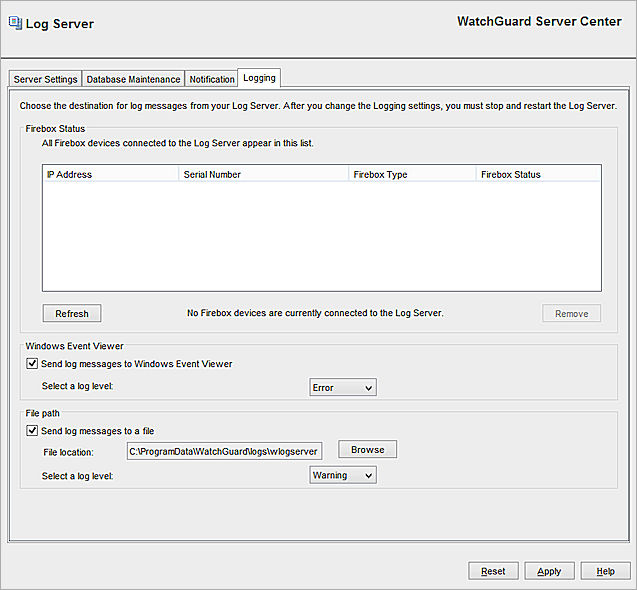
Related Topics
Configure Logging Settings for the Log Server
From WatchGuard Server Center, you can see the status of your connected Fireboxes, and configure Windows Event Viewer and file path settings for your Log Server.
- In the Servers tree, select Log Server.
- Select the Logging tab.
The Logging page appears.

- Configure the settings for your Log Server, as described in the next sections.
- When you are finished, click Apply to save your changes.
When you change the Logging settings for a WatchGuard server, you must stop and restart the server before the changes can take effect. For more information about how to stop and restart a WatchGuard server, see Stop and Start Your WatchGuard Servers.
See the Status of your Devices
The Firebox Status window shows the list of all Fireboxes connected to the Log Server. You can refresh the view to update the list, or delete devices from the list.
- To see the current status of the device connections, click Refresh.
A message appears if no Fireboxes are connected to the Log Server. - To delete a device from the list, in the Firebox Status list, select a device. Click Remove.
The selected device is removed from the Firebox Status list.
Configure Logging to Windows Event Viewer
You can choose to send server log messages to the Windows Event Viewer.
- Select the Send log messages to Windows Event Viewer check box.
- From the Select a log level drop-down list, select the log level to assign to the log messages:
- Error
- Warning
- Information
- Debug
For more information about log levels, see Log Message Levels.
Save Log Messages in a Log File
You can choose to save server log messages in a file that you can review later. This option is enabled by default.
To change the log file settings:
- To save log messages in a file, make sure the Send log messages to a file check box is selected.
- In the File Location text box, type the path to the directory where you want the log file to be stored.
Or, click Browse to select the directory. - From the Select a log level drop-down list, select the level to assign to log messages:
- Error
- Warning
- Information
- Debug
For more information about log levels, see Log Message Levels.
See Also
Configure Database Size, Authentication Key, and Diagnostic Log Settings
Configure Database Maintenance Settings